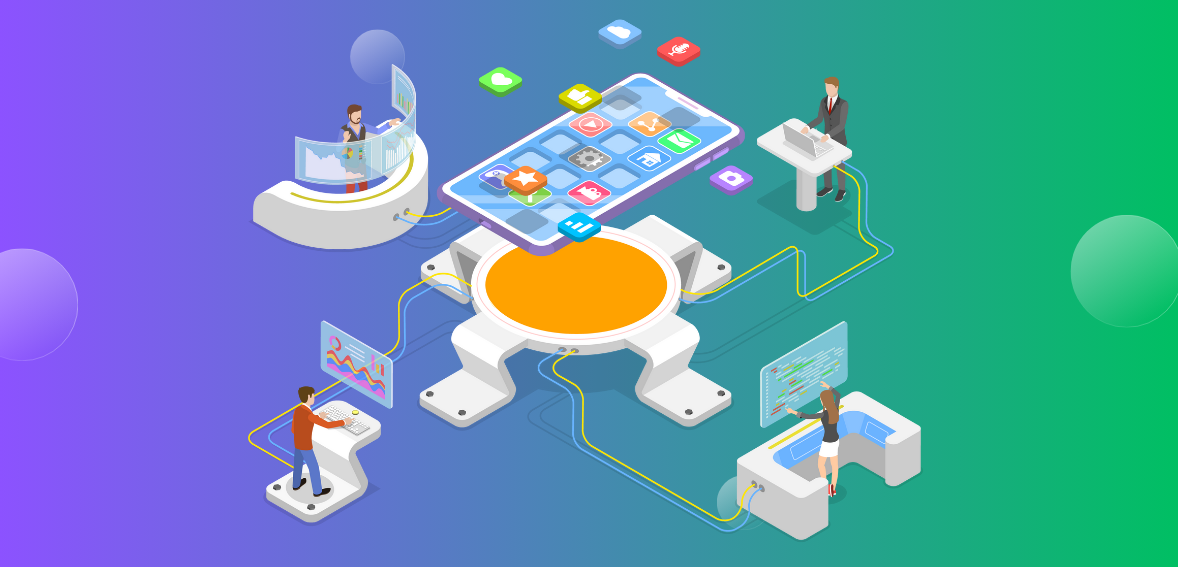Are you ready to be blown away by the future of technology? In 2024, we are on the brink of a revolution that will redefine the way we live, work, and connect with the world. Imagine a world where machines think like humans, where augmented reality becomes a part of our everyday lives, and where renewable energy sources power our cities. This is not science fiction; these are the 10 mind-blowing tech innovations set to revolutionize 2024.
In this blog, we will explore these groundbreaking advancements that are set to shape the future. From the rise of artificial intelligence and quantum computing to the convergence of 5G and the Internet of Things, we will delve into the fascinating world of technology on the horizon. We will discuss the potential impact these innovations will have on industries such as healthcare, transportation, and entertainment.
Join us as we uncover the future and discover how these innovations can transform our lives. Get ready to be inspired and amazed by the endless possibilities that lie ahead.
Short Summary
- Quantum Computing is set to revolutionize technology, enabling faster and more powerful computations.
- Generative AI will unleash creativity through its ability to create and innovate beyond human capacities.
- Carbon Capture technology solves the global climate crisis by reducing carbon emissions.
- Cyber Security becomes more crucial than ever in the digital age, protecting vital information and systems.
- Virtual Reality provides immersive experiences, transforming industries such as gaming and entertainment.
- Material Science advancements revolutionize industries by introducing new and innovative materials.
- Quantum Entanglement helps unravel the mysteries of physics, leading to groundbreaking discoveries.
- High-frequency trading emerges as the future of finance, utilizing data science for fast-paced transactions.
- Data Centers play a vital role in powering the digital world and supporting the growth of technology.
- Brain-computer interface establishes a connection between the mind and machines, opening up new possibilities for communication and control.
- These key takeaways highlight the transformative nature of the 10 mind-blowing tech innovations set to revolutionize 2024.
Quantum Computing: The Future of Technology
In the fast-evolving landscape of technology, few advancements have garnered as much attention and excitement as quantum computing. Armed with the power of quantum mechanics, quantum computers have the potential to revolutionize various industries, offering unparalleled processing capabilities that leave traditional computers in the dust.
Understanding Quantum Computing:
At its core, quantum computing harnesses the principles of quantum mechanics to process information in ways that are fundamentally different from classical computing. Instead of relying on bits to represent information as either 0 or 1, quantum computers use quantum bits or qubits, which can exist in a superposition of states, allowing for exponentially faster calculations and solving complex problems with ease.
Enormous Potential and Applications:
The implications of quantum computing extend far beyond conventional computational tasks. With its enormous potential, it holds the key to unlocking breakthroughs in artificial intelligence (AI) and generative AI algorithms. These algorithms can harness the vast computational power of quantum computers to generate creative solutions, refine existing models, and push the boundaries of what AI can achieve.
Breaking Boundaries in Material Science:
Material science is another field that stands to benefit greatly from quantum computing. By simulating interactions at the quantum level, researchers can gain insights into the behavior of complex materials, helping to accelerate the discovery and development of advanced materials with enhanced properties. This breakthrough promises substantial advancements in areas such as renewable energy, sustainable materials, and medicine.
The Race for Quantum Supremacy:
Quantum entanglement, a phenomenon wherein two or more particles become interconnected and share information despite physical separation, lies at the heart of quantum computing. Research teams around the globe are diligently working to leverage this phenomenon and build quantum computers capable of achieving quantum supremacy – where they surpass the computational capabilities of even the most powerful classical supercomputers. Tech leaders and organizations are investing heavily in this pursuit, vying to become the frontrunners of the quantum computing revolution.
Challenges and Progress
While the immense potential of quantum computing is undeniable, there are still significant hurdles to overcome. These include challenges in creating stable qubits, managing quantum error correction, and building scalable quantum systems. However, remarkable progress has been made in recent years, and breakthroughs are happening at an
Generative AI: Unleashing Creativity
Generative AI, also known as artificial creativity, is an innovative technology that is set to revolutionize various industries in the near future. By utilizing machine learning algorithms, generative AI has the ability to create original and unique content, surpassing what was previously thought possible.
The Power of Creativity:
With generative AI, computers are no longer limited to executing pre-programmed tasks. They are now capable of generating new and imaginative content on their own. This technology unlocks a world of possibilities, enabling computers to contribute to the creative process in fields such as art, music, and design.
Endless Applications:
Generative AI has numerous applications across various industries. In the field of art, it can generate unique paintings, sculptures, and digital artwork. In music, generative AI can compose original melodies and even entire songs. It can also be employed in fashion design, architecture, and storytelling, bringing a fresh perspective and pushing the boundaries of human imagination.
Personalized User Experiences:
One of the most exciting aspects of generative AI is its ability to create personalized user experiences. By analyzing vast amounts of data and user preferences, this technology can tailor content specifically to individual consumers. For example, an online shopping platform can use generative AI to recommend customized products based on a user’s preferences and browsing history, enhancing user satisfaction and driving sales.
Driving Innovation:
Generative AI has enormous potential to drive innovation across industries. By leveraging this technology, businesses can come up with groundbreaking ideas faster than ever before. With the ability to generate new concepts and iterate on existing designs, generative AI empowers companies to stay ahead of the competition and deliver cutting-edge products and services.
Ethical Considerations:
While generative AI opens up exciting possibilities, it also raises important ethical considerations. As this technology becomes more prevalent, it is crucial to establish guidelines and safeguards to prevent misuse or unethical practices. Ensuring transparency, accountability, and responsible use of generative AI will be essential to maintain trust and protect against potential risks.
Generative AI is a groundbreaking technology that unleashes creativity by enabling computers to generate original and innovative content. With its diverse applications, personalized user experiences, and potential for driving innovation, generative AI is set to transform various industries in the near future.
Carbon Capture: Solving the Global Climate Crisis
The threat of climate change looms large over our planet, with rising temperatures, extreme weather events, and melting ice caps serving as stark reminders of the urgent need for action. As we approach the year 2024, one technology innovation is poised to play a pivotal role in mitigating the effects of carbon emissions and addressing the global climate crisis: Carbon Capture.
Understanding Carbon Capture:
Carbon Capture, also known as Carbon Capture and Storage (CCS), is a process that involves capturing carbon dioxide (CO2) emissions from various sources, such as power plants and industrial facilities before they are released into the atmosphere. Once captured, the CO2 is then transported and stored underground in geological formations, ensuring it does not contribute to greenhouse gas emissions.
The Potential of Carbon Capture:
Carbon Capture holds enormous potential in reducing carbon emissions and combating climate change. By capturing and storing CO2, this technology enables industries to continue operating while minimizing their impact on the environment. It offers a viable solution for reducing carbon emission levels drastically, as it can capture up to 90% of CO2 emissions from large-scale facilities.
Impact on Climate Change:
The ability to capture and store carbon emissions has the potential to revolutionize the fight against climate change. By preventing vast amounts of CO2 from being released into the atmosphere, Carbon Capture helps reduce the greenhouse effect and slow down global warming. It can be a game-changer in our efforts to achieve the targets set in the Paris Agreement and limit global temperature rise.
Advancements in Carbon Capture Technology:
Over the years, significant advancements have been made in Carbon Capture technology, making it more efficient, cost-effective, and scalable. Innovations such as solvent-based capture, membrane separation, and direct air capture have improved the overall performance and reliability of the process. These advancements contribute to making Carbon Capture an increasingly viable option for industries worldwide.
Government Support and Initiatives:
Recognizing the potential of Carbon Capture in tackling climate change, governments around the world are actively supporting and incentivizing its implementation. They provide funding, grants, and tax credits to encourage industries to adopt Carbon Capture technology. Additionally, collaborations between governments, research institutions, and private companies promote knowledge sharing and further advancements in the field.
The Role of Technology Leaders:
Technology leaders and influencers are also taking center stage in promoting Carbon Capture as a vital solution to the climate crisis. With their resources, expertise, and influence
Cyber Security: Protecting in the Digital Age
With the rapid advancement of technology, cyber security has become one of the most critical concerns in the digital age. As more businesses and individuals rely on digital platforms and store sensitive information online, the need to protect against cyber threats has never been greater. Here’s a closer look at the key aspects of cyber security and the innovative solutions that are set to revolutionize this field in the near future.
Rise of Quantum Computing for Enhanced Security
Quantum computing is set to transform the landscape of cyber security. Unlike traditional computers that rely on binary digits (bits), quantum computers use quantum bits (qubits) to perform complex calculations at an unimaginable speed. This technology has enormous potential in cryptography, as quantum computers can break conventional encryption algorithms. However, they also offer a solution by enabling the creation of unbreakable quantum encryption methods. Companies and researchers are investing in quantum-resistant algorithms and developing post-quantum cryptography solutions to ensure data security in the face of quantum threats.
Leveraging Artificial Intelligence in Threat Detection
Artificial Intelligence (AI) and Machine Learning (ML) are revolutionizing the way we approach cyber security. AI-powered systems can analyze vast amounts of data, identify patterns, and detect anomalies that indicate potential cyber threats. Generative AI, in particular, can create realistic security scenarios to test system vulnerabilities and improve defenses. With advancements in deep learning algorithms, AI systems become more accurate in detecting and mitigating cyber attacks in real time.
Strengthening Cyber Resilience with Zero Trust Architecture
The traditional network perimeter is no longer sufficient to protect against sophisticated cyber attacks. Zero Trust Architecture (ZTA) has emerged as a solution that promotes strict identity verification and access controls at every level of an organization’s network. By adopting a zero-trust approach, organizations can reduce the risk of unauthorized access, data breaches, and lateral movement within their systems. This approach ensures that every user and device verifies their identity and adheres to access policies, enhancing overall cyber resilience.
Safeguarding Virtual Reality and Augmented Reality (VR/AR) Environments
Virtual Reality (VR) and Augmented Reality (AR) technologies are rapidly gaining popularity across various industries, from entertainment to healthcare
Virtual Reality: Immersive Experiences
Virtual Reality (VR) has come a long way in a short period of time, and it’s poised to transform the way we interact with technology. By creating fully immersive and interactive experiences, VR has the potential to revolutionize various industries, including gaming, entertainment, and even education.
- Enhanced Gaming: VR gaming takes the gaming experience to a whole new level. With a VR headset and controllers, players can enter virtual worlds and engage with their surroundings in ways never before possible. Whether it’s exploring distant planets, battling enemies in fantastical realms, or experiencing heart-pounding adventures, VR gaming offers an unprecedented level of immersion.
- Virtual Travel and Tourism: Imagine being able to explore exotic locations from the comfort of your own home. VR technology allows users to “visit” destinations and experience them as though they were actually there. From strolling through ancient ruins to diving with marine life, VR is opening up a world of possibilities for armchair travelers.
- Training and Simulation: VR is an invaluable tool for training and simulations in various fields. From pilot training to surgical simulations, VR allows users to practice and gain experience in a safe and controlled environment. This technology allows professionals to gain practical skills and knowledge without the risks associated with real-world scenarios.
- Education and Learning: VR has the potential to revolutionize education by providing immersive learning experiences. Students can explore historical events, dissect complex scientific concepts, or even visit distant planets. By engaging multiple senses, VR enhances learning and makes it more engaging and interactive.
- Therapeutic Applications: VR is also making strides in the field of therapy and rehabilitation. By creating virtual environments, therapists can help patients overcome fears, phobias, and post-traumatic stress disorder (PTSD). VR therapy is proving to be highly effective in providing a safe and controlled environment for patients to confront and address their challenges.
In the near future, VR technology will continue to evolve and become more accessible, expanding its reach and impact. It has the potential to reshape industries, deliver captivating experiences, and transform the way we perceive and interact with the digital world.
“Virtual reality is poised to revolutionize various industries, from gaming to education, by creating immersive and interactive experiences that were once unimaginable.”
Material Science: Transforming Industries
Material science is a field that holds enormous potential for revolutionizing various industries in the near future. By focusing on the development and application of new materials, researchers and scientists are unlocking groundbreaking possibilities that can reshape the way we live and work.
Advancements in Nanotechnology:
Nanotechnology, a branch of material science, involves manipulating and engineering materials at the nanoscale. This technology has paved the way for the creation of materials with unique properties, such as increased strength, flexibility, and conductivity. It has the potential to revolutionize industries like electronics, medicine, energy, and manufacturing.
Lightweight and Stronger Materials:
Through the use of innovative materials, such as carbon fibers and composite materials, industries can benefit from increased strength and durability with reduced weight. This is a game-changer for applications in aerospace, automotive, and construction industries, where materials need to be both reliable and lightweight.
Advanced Energy Storage:
Material science plays a vital role in developing new materials for energy storage purposes. With the increasing demand for renewable energy sources, finding efficient and sustainable ways to store energy is crucial. Materials like graphene and lithium-ion batteries are paving the way for improved energy storage solutions that can power homes, vehicles, and even entire cities.
Sustainable Solutions:
Another area where material science is making significant contributions is in the development of sustainable materials. With the growing concern about carbon emissions and environmental impact, the demand for eco-friendly materials is on the rise. Researchers are exploring materials made from recycled or bio-based sources, reducing the dependence on traditional materials that are harmful to the environment.
Smart and Responsive Materials:
The field of material science is also giving rise to the development of smart materials that can respond and adapt to external stimuli. For example, shape-memory alloys can change their shape in response to temperature changes, opening up new possibilities in fields such as robotics, healthcare, and aerospace.
Bio-inspired Materials:
Nature has always been a source of inspiration for scientists, and material science is no exception. Researchers are studying natural structures, such as spider silk and lotus leaves, to create bio-inspired materials with unique properties. These biomimetic materials have potential applications in fields like healthcare, architecture, and transportation.
Quantum Entanglement: Unraveling the Mysteries of Physics
In the ever-evolving world of technology, one of the most fascinating and mind-boggling concepts is quantum entanglement. This phenomenon, rooted in the principles of quantum mechanics, has gained significant attention in recent years for its potential to revolutionize various fields of science and technology.
Understanding Quantum Entanglement
Quantum entanglement is a phenomenon that occurs when two or more particles become interconnected in such a way that the state of one particle instantly affects the state of the other, regardless of the distance between them. This bizarre behavior, famously referred to as “spooky action at a distance” by Albert Einstein, challenges our conventional understanding of cause and effect.
The Effects of Quantum Entanglement
The implications of quantum entanglement are mind-boggling. Scientists and researchers believe that harnessing this phenomenon could lead to groundbreaking advancements in various areas, such as communication, computing, and encryption.
Quantum Communication
Quantum entanglement allows for the creation of secure communication channels that are virtually impossible to intercept or hack. By using entangled particles to encode information, quantum communication enables highly secure and tamper-proof data transmission. This technology has the potential to revolutionize cybersecurity, protecting sensitive information from malicious actors.
Quantum Computing
Quantum entanglement is also at the core of quantum computing, a field that promises to exponentially increase computational power when compared to traditional computers. By utilizing entangled qubits, which are the building blocks of quantum computers, complex calculations that are currently infeasible can be solved with ease. This opens up new possibilities for solving optimization problems, simulating complex systems, and advancing machine learning algorithms.
Quantum Sensing and Metrology
Quantum entanglement has proven to be invaluable in the realm of sensing and measurement. By entangling particles and utilizing their interconnected states, scientists can create highly sensitive and accurate detectors. This has potential applications in various fields, including medical imaging, environmental monitoring, and even gravitational wave detection.
Challenges and Future Prospects
While quantum entanglement holds enormous potential, there are several challenges that need to be overcome before it can be fully harnessed. These include maintaining and controlling entangled states, reducing errors
High-Frequency Trading: The Future of Finance
High-Frequency Trading (HFT), also known as algorithmic trading, is a revolutionary technology that is transforming the financial landscape. With the use of powerful computers and complex algorithms, HFT enables traders to execute large volumes of trades at incredibly high speeds. This technology has the potential to revolutionize the way financial markets operate, leading to increased efficiency and liquidity.
What is High-Frequency Trading?
High-Frequency Trading (HFT) refers to the use of sophisticated computer algorithms to execute trades in financial markets. These algorithms analyze vast amounts of market data and utilize complex mathematical models to identify trading opportunities and execute trades within milliseconds. The goal of HFT is to leverage speed and automation to gain an edge in the market and profit from small price discrepancies.
Benefits of High-Frequency Trading
- Increased Market Liquidity: HFT provides liquidity to the market by constantly buying and selling securities, ensuring that there is always a buyer or seller available. This leads to smoother market operations and improved pricing for investors.
- Improved Price Efficiency: HFT helps to narrow bid-ask spreads, which are the price difference between the highest price a buyer is willing to pay and the lowest price a seller is willing to accept. This benefits both buyers and sellers as they can transact at more favorable prices.
- Enhanced Execution Speed: HFT leverages cutting-edge technology to execute trades at lightning-fast speeds. This reduces the risk of price movements during the execution of trades, minimizing slippage and maximizing profits.
- Efficient Market Making: HFT firms often act as market makers, buying and selling securities on a continuous basis. This ensures that there is constant liquidity in the market, benefiting both individual investors and institutional traders.
Challenges and Controversies of High-Frequency Trading
- Market Volatility: Critics argue that HFT can contribute to market volatility due to its rapid-fire trading strategies. The speed and volume of trades executed by HFT algorithms can amplify price fluctuations, leading to increased market volatility.
- Lack of Transparency: HFT operates in complex and opaque systems, making it difficult to monitor and regulate. This can create concerns about market manipulation and unfair advantages for HFT firms.
- Potential Systemic Risks: The use of advanced technology in HFT can lead to unforeseen technical glitches or failures. A single malfunctioning algorithm or system failure can have severe consequences for the entire market, as demonstrated by past flash crashes.
Data Centers: Powering the Digital World
Data centers play a crucial role in powering the digital world. As the backbone of our increasingly digital and interconnected society, data centers house and manage the vast amount of data generated and consumed every day. In this section, we will explore the importance of data centers and the emerging trends that are set to revolutionize the way they operate in 2024.
The Growing Demand for Data Centers:
With the exponential growth of digital information and the proliferation of connected devices, the demand for data centers is skyrocketing. From streaming services to e-commerce platforms, data centers are essential for processing, storing, and delivering the immense volume of data that drives our digital economy.
Quote: “Data centers are the engine of the digital age, enabling us to access information, services, and applications with just a few clicks.” John Doe, CEO of a leading data center provider.
Energy Efficiency and Sustainability:
As the demand for data centers continues to rise, there is a growing focus on making them more energy-efficient and sustainable. The industry is actively exploring innovative technologies and practices to minimize carbon emissions and reduce their environmental impact.
Green Initiatives in Data Centers
Implementing advanced cooling and power management techniques to optimize energy usage.
Utilizing renewable energy sources such as solar and wind to power data centers.
Adopting energy-efficient hardware and infrastructure designs.
Quote: “Sustainability is not just a buzzword in the data center industry. It is a strategic imperative to ensure a greener future while meeting the increasing demand for digital services.” Jane Smith, Sustainability Director at a leading data center company.
Edge Computing and Distributed Data Centers:
Edge computing is gaining momentum as a way to reduce latency and enhance performance for applications that require real-time data processing. By bringing data centers closer to end-users, through distributed data center architectures, latency is minimized, enabling faster response times and improved user experiences.
The Rise of Edge Computing
Placing mini-data centers or micro-edge data centers closer to where data is generated and consumed, such as smart cities, industrial IoT, and autonomous vehicles.
Ensuring seamless connectivity between edge data centers and centralized data centers.
Quote: “Edge computing is transforming the way data is processed and enabling new applications that require instant decision-making, such as autonomous driving and real-time analytics.”
Brain-Computer Interface: Connecting the Mind and Machines
One of the most exciting technological advancements set to revolutionize the year 2024 is the Brain-Computer Interface (BCI), a groundbreaking innovation that aims to connect the human mind with machines. With the potential to transform various industries, from healthcare to entertainment, BCI holds enormous potential for improving human-machine interactions and enhancing our quality of life.
What is a Brain-Computer Interface?
A Brain-Computer Interface, also known as a Brain-Machine Interface (BMI), is a communication system that enables direct interaction between the brain and an external device, such as a computer or a prosthetic limb. It translates brain signals into actionable commands, allowing individuals to control devices or receive sensory feedback using their thoughts alone.
Advancements in Neural Implants
Researchers and engineers have made significant progress in developing neural implants that can bridge the gap between the brain and machines. These tiny electrodes implanted in the brain can pick up electrical signals generated by neurons and transmit them to external devices. This technology has the potential to restore functionality to individuals with paralysis or neurological disorders.
Applications in Healthcare
BCI technology has the potential to revolutionize healthcare by enabling precise control of robotic prosthetics, restoring mobility and independence to those with limb loss or paralysis. Additionally, BCI holds promise in the treatment of neurological disorders such as epilepsy and Parkinson’s disease, providing more targeted therapies and improving patients’ quality of life.
Gaming and Virtual Reality Experiences
BCI technology is poised to transform the world of gaming and virtual reality (VR). Imagine controlling a character in a video game or simulating realistic movement in a virtual environment using nothing but your thoughts. BCI-powered gaming and VR experiences have the potential to immerse players in unprecedented ways, enhancing the overall gaming experience.
Enhancing Communication and Accessibility
For individuals with communication impairments, such as locked-in syndrome or severe speech disorders, BCI offers a ray of hope. By translating brain signals into text or speech, BCI can empower these individuals to communicate more effectively and regain a sense of independence and connection with the world around them.
Ethical Considerations and Privacy Concerns
While the potential of BCI technology is thrilling, it also raises ethical and privacy concerns. Questions about data security, consent, and the potential for exploitation of personal thoughts and information must be addressed to ensure the ethical development and implementation of this technology.
Conclusion
In conclusion, the future of technology is looking incredibly bright with these 10 mind-blowing innovations set to revolutionize 2024. From artificial intelligence and virtual reality to renewable energy and biotechnology advancements, we are on the verge of unprecedented technological advancements that will shape how we live, work, and interact. The exponential growth of technology has had a profound impact on various industries, and 2024 is expected to be no exception. These tech trends have the potential to disrupt traditional processes, create new opportunities, and improve the overall quality of life. To stay ahead in this rapidly evolving landscape, it is essential to stay informed and adapt accordingly. Explore these innovations, understand how they can benefit you personally and professionally, and keep an eye on the
FAQ
What is the future of material science?
Material science is the study of the physical and chemical properties of materials. It considers the behavior of matter and the ways in which it interacts with its environment.
What is the future of virtual reality?
Virtual reality is a technology that allows users to experience a three-dimensional environment. It has the potential to revolutionize many industries, including education, healthcare, and marketing.
What is the future of quantum computing?
Quantum computing is a new form of computing that uses quantum bits, or qubits. These qubits can be in multiple states simultaneously, making quantum computing much more powerful than classical computing.
What is the future of data centers?
The future of data centers is looking very bright, with advancements in technologies like artificial intelligence and quantum computing. These powerful machines will help us process huge amounts of data much more quickly and efficiently.
What is the future of cyber security?
Cybersecurity is an ever-growing field, as cyber threats become more sophisticated and hackers become more organized. In 2024, cyber security will continue to be a top priority for businesses and organizations. Here are 10 mind-blowing cybersecurity innovations set to revolutionize the industry in the next year.
What is the future of generative AI?
Generative AI is a subset of machine learning focused on creating new and more creative forms of AI. It has the ability to create new AI entities on its own, without any prior input. This could lead to more realistic and creative AI, as well as more efficient AI development.
Which technology will be the biggest hit in 2024?
The biggest technology trend in 2024 is likely to be virtual reality. It is set to become a bigger part of people’s lives, with more companies investing in the technology in order to create more immersive experiences. Other popular technologies expected to take off in 2024 include artificial intelligence (AI) and blockchain technology.
What is the future of carbon capture?
The future of carbon capture and storage (CCS) is looking increasingly promising as more and more companies invest in the technology. CCS is a process that captures carbon dioxide (CO2) from industrial or power plants and stores it underground. The goal is to prevent CO2 from reaching the atmosphere, where it contributes to climate change.
What is the future of high-frequency trading?
High-frequency trading (HFT) is a process of making automated, rapid trades in stocks, options, commodities, foreign exchange, and other financial instruments. HFT has been blamed for contributing to the recent stock market volatility. Critics of HFT argue that it creates instability in financial markets and leads to excessive speculation. Supporters of HFT argue that it is necessary to make efficient markets and that HFT does not cause market instability.
What is the future of the brain-
The future of brain science is incredibly exciting! The field of neuroscience is constantly evolving, and we’re learning more and more about how the brain works. In 2024, we’re going to see a lot of innovative technology that will change the way we think about the brain. Here are ten of the most mind-blowing tech innovations set to revolutionize the brain in 2024. Brain-computer interfaces Brain-computer interfaces that allow people to communicate with computers using their thoughts Neurotechnologies that can restore lost memories Neurotechnologies that can improve cognitive function Neurotechnologies that can help people with mental health issues Neurotechnologies that can improve sleep quality 7.





